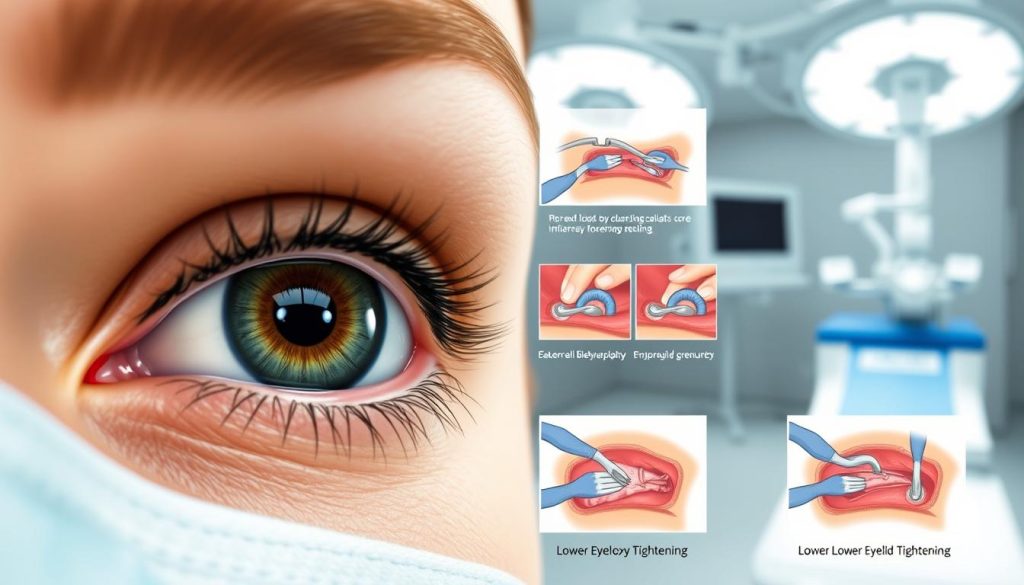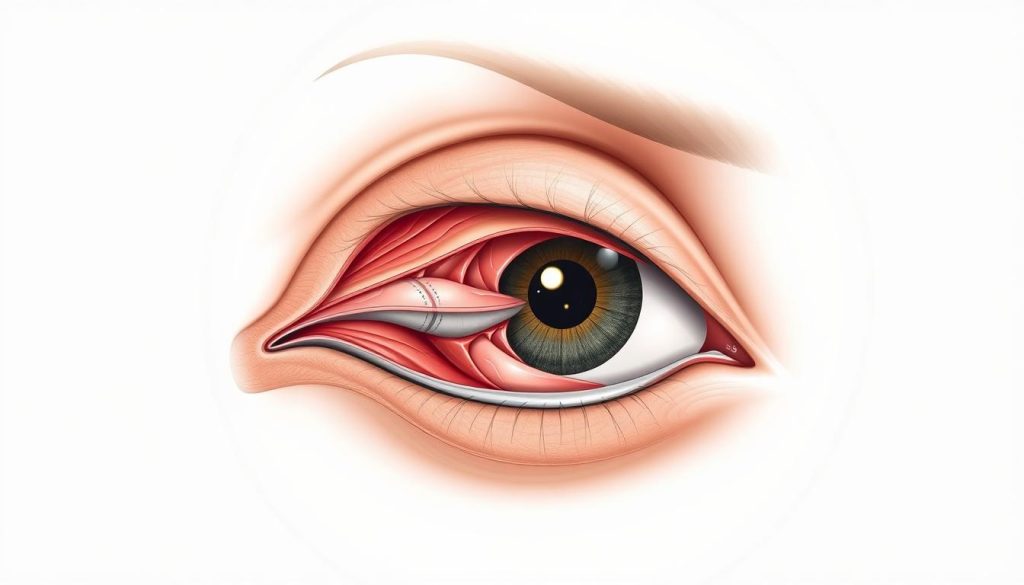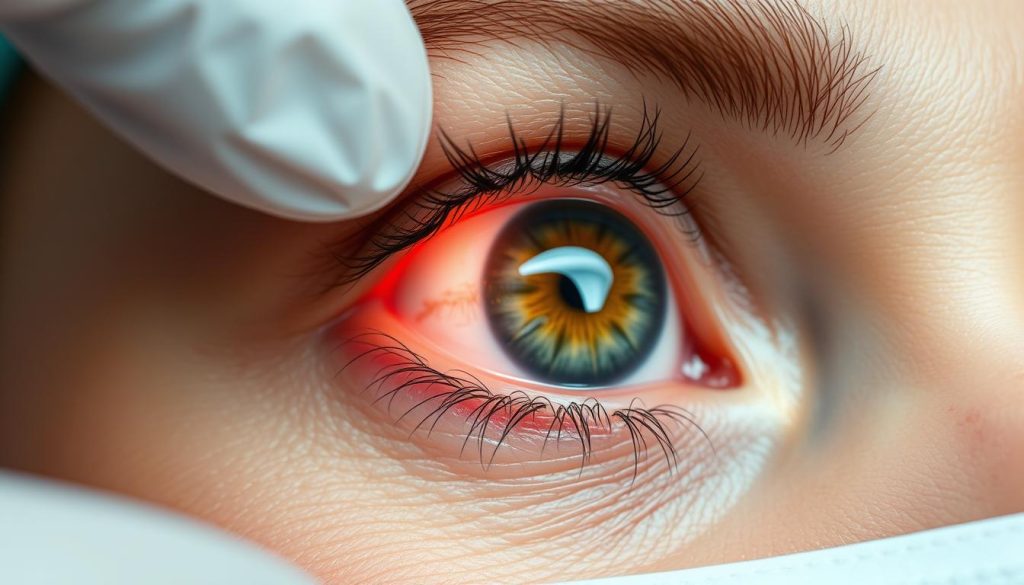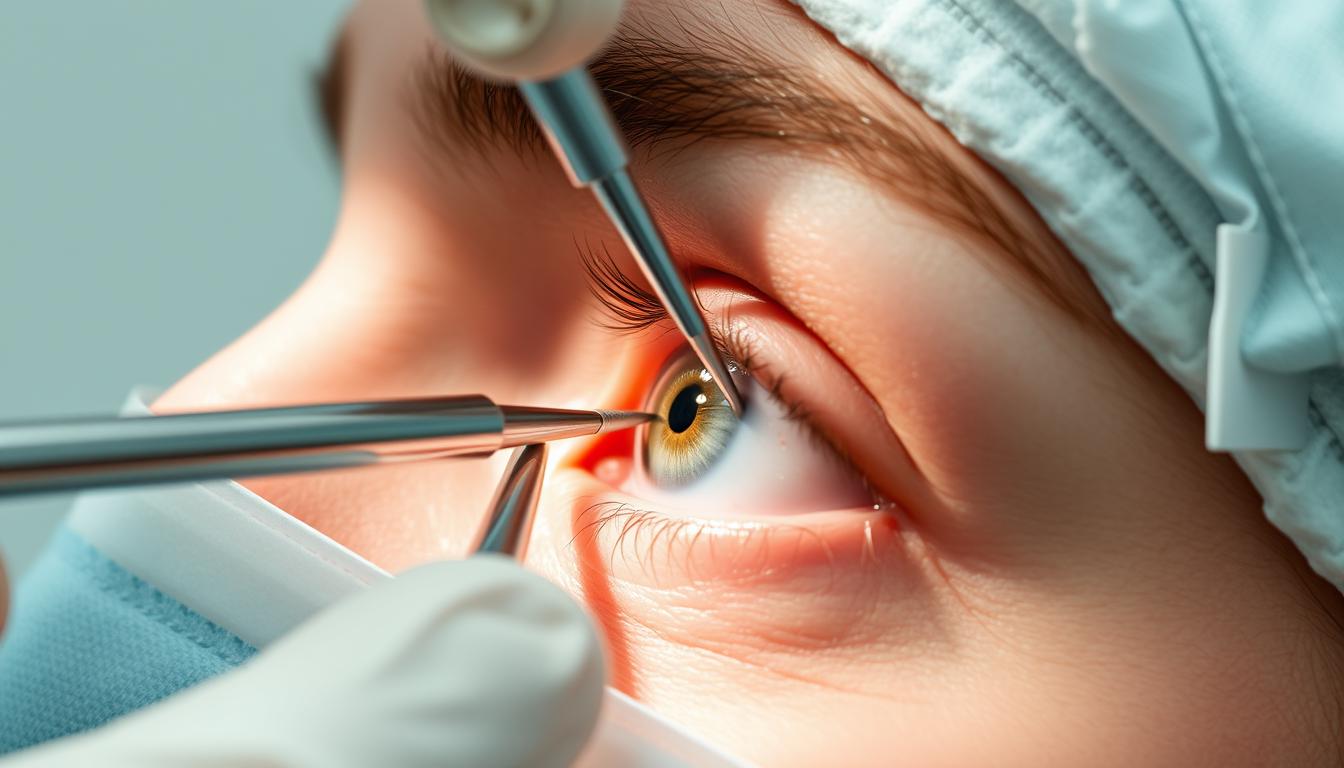As individuals age, the area around their eyes often shows the first signs of wear, including under-eye bags, puffiness, and excess skin. Lower eyelid plastic surgery, also known as blepharoplasty, is a procedure designed to rejuvenate the appearance of tired or aged eyes.
This cosmetic and sometimes functional procedure targets common concerns, enhancing the overall appearance of the eyelid area. Various approaches and techniques are available for lower eyelid surgery, making it a versatile option within the broader context of facial rejuvenation procedures.
Key Takeaways
- Lower eyelid plastic surgery addresses signs of aging around the eyes.
- Blepharoplasty can rejuvenate the appearance of tired or aged eyes.
- The procedure targets under-eye bags, puffiness, and excess skin.
- Different approaches and techniques are available for lower eyelid surgery.
- Understanding the procedure is crucial before making a decision.
What Is Lower Eyelid Plastic Surgery?
Lower eyelid plastic surgery, also known as lower blepharoplasty, is a surgical procedure aimed at rejuvenating the appearance of the lower eyelids. This surgery addresses various aesthetic concerns that can make a person appear tired, angry, or older than they are.
Definition and Purpose
Lower blepharoplasty is a cosmetic surgical procedure designed to address various aesthetic concerns related to the lower eyelids. The primary purpose of this surgery is to restore a youthful and refreshed appearance by addressing issues such as under-eye bags, puffiness, and skin laxity. By doing so, it aims to improve the overall facial appearance without drastically changing one’s look.
Common Aesthetic Concerns Addressed
Lower eyelid plastic surgery addresses several common aesthetic concerns, including:
- Under-eye bags and puffiness caused by fat pads beneath the eyes.
- Tear troughs, or hollow areas between the lower eyelid and cheek, which can contribute to a tired appearance.
- Skin laxity issues in the lower eyelids, affecting overall facial appearance.
- Dark circles and shadows formed due to structural changes in the lower eyelid area.
These concerns can significantly impact a person’s appearance and self-perception. Lower eyelid surgery offers a solution by improving the appearance of the lower eyelids, resulting in a more rested and youthful look.
| Aesthetic Concern | Description | Impact on Appearance |
|---|---|---|
| Under-eye bags | Caused by fat pads beneath the eyes | Makes one look tired or older |
| Tear troughs | Hollow areas between the lower eyelid and cheek | Contributes to a tired appearance |
| Skin laxity | Loosening of skin in the lower eyelids | Affects overall facial appearance |
As noted by a renowned plastic surgeon, “Lower blepharoplasty can significantly enhance one’s appearance by addressing the aging effects on the lower eyelids, resulting in a more youthful and refreshed look.” This quote highlights the potential benefits of lower eyelid plastic surgery in achieving a more vibrant appearance.
Types of Lower Eyelid Plastic Surgery Techniques

The field of lower eyelid plastic surgery offers a range of techniques, from the transconjunctival to the transcutaneous approach. These techniques are designed to address various aesthetic concerns related to the lower eyelids, including excess skin, muscle laxity, and fat deposits.
Transconjunctival Approach
The transconjunctival approach is a technique used in lower eyelid blepharoplasty that involves making an incision on the inner surface of the lower eyelid. This method is preferred when the primary concern is the removal or repositioning of fat.
It is less invasive compared to the transcutaneous approach and does not result in visible external scarring. However, it has limitations, particularly in addressing skin laxity or muscle weakness.
Transcutaneous Approach
The transcutaneous approach involves making an external incision just below the lower eyelash line, allowing for the tightening of the muscles of the lower lid and the trimming and repositioning of excess skin and fat.
This technique is more versatile, enabling surgeons to address multiple concerns simultaneously, including excess skin, muscle laxity, and fat deposits. The precise placement of the incision, typically 1-2 mm below the lash line, helps minimize visible scarring.
- Comprehensive explanation of the transcutaneous approach, which involves an external incision made just below the lower eyelash line.
- Description of how this technique allows surgeons to address multiple concerns simultaneously: excess skin, muscle laxity, and fat deposits.
- Explanation of the precise placement of the incision (1-2mm below the lash line) to minimize visible scarring.
- Discussion of how this approach enables muscle tightening, which isn’t possible with the transconjunctival technique.
- Overview of when this approach is most appropriate – typically for patients with significant skin laxity or muscle weakness.
- Explanation of potential risks specific to this technique, including the possibility of lower eyelid retraction.
While the transcutaneous approach is more invasive and carries the risk of lower eyelid retraction, it is a valuable technique for addressing complex aesthetic concerns of the lower eyelid.
Determining If You’re a Candidate
To ensure a successful outcome, it’s essential to identify if you’re a suitable candidate for lower eyelid surgery. This involves a comprehensive evaluation of your overall health and specific eyelid concerns.
Ideal Candidates for Lower Eyelid Surgery
Ideal candidates for lower eyelid surgery are typically those who are in good health, have realistic expectations, and are bothered by the appearance of their lower eyelids due to aging, genetics, or other factors. These individuals should be non-smokers or willing to quit smoking before and after surgery to minimize complications.
Medical Considerations and Contraindications
Certain medical conditions can impact your eligibility for lower eyelid surgery. Conditions such as thyroid disorders, dry eye syndrome, and high blood pressure may require special consideration. It’s crucial to disclose your full medical history to your surgeon during the consultation to assess potential risks and determine the best approach for your individual needs. 
Patients with certain eye conditions or taking specific medications may need to take extra precautions or might be advised against undergoing surgery. Your surgeon will guide you through the process, ensuring that you’re making an informed decision about your candidacy for lower eyelid surgery.
Preparing for Lower Eyelid Plastic Surgery
Preparing for lower eyelid plastic surgery involves several crucial steps that ensure a smooth and successful procedure. This preparation is key to achieving the desired outcomes and minimizing potential complications.
Pre-Surgical Consultation Process
The first step in preparing for lower blepharoplasty is a comprehensive consultation with a qualified surgeon. At Amadi Aesthetics, Dr. Amadi will review the patient’s medical history, examine their symptoms, and devise a personalized plan. This consultation is critical in determining the best approach for the lower eyelid surgery, taking into account the patient’s specific needs and health status.
During this consultation, the surgeon will discuss the patient’s expectations, assess their overall health, and outline the procedure in detail. This is also an opportunity for the patient to ask questions and understand the risks and benefits associated with the surgery.
Pre-Operative Instructions
Following the consultation, patients will receive detailed pre-operative instructions to prepare them for the surgery. These instructions typically include guidance on medications to avoid, such as aspirin and NSAIDs, which can increase the risk of bleeding. Patients are also advised to stop smoking several weeks before and after the procedure to promote optimal healing.
| Pre-Operative Instruction | Description |
|---|---|
| Medications to Avoid | Aspirin, NSAIDs, and certain supplements that can increase bleeding risk |
| Smoking Cessation | Stop smoking several weeks before and after the procedure |
| Dietary Restrictions | Fasting requirements before the procedure |
| Practical Preparations | Arrange transportation home after surgery and set up a recovery area |
Additionally, patients may be required to undergo lab work and obtain medical clearances before scheduling the lower blepharoplasty. They will also be instructed on how to prepare their recovery area, including gathering necessary supplies such as prescribed medications, cold compresses, and eye drops.
The Lower Eyelid Plastic Surgery Procedure
The lower eyelid plastic surgery procedure is a nuanced operation that aims to restore a youthful appearance by addressing various aesthetic concerns. It involves a range of techniques to tackle issues such as prolapsed fat, stretched-out eyelid muscle and skin, and cheek descent.
Anesthesia Options
Lower eyelid blepharoplasty can be performed under local anesthesia with sedation or general anesthesia, depending on the patient’s preference and the surgeon’s recommendation. The choice of anesthesia is crucial for ensuring patient comfort during the procedure.
Step-by-Step Surgical Process
The surgical process involves making precise incisions, either through the conjunctiva or the skin, to access the fat pads and muscle. The technique used depends on the patient’s anatomy and the surgeon’s expertise. The goal is to achieve a smooth, natural-looking eyelid-cheek junction.
Fat Repositioning vs. Fat Removal
A key decision in lower eyelid blepharoplasty is whether to use fat repositioning or fat removal. Fat repositioning is often preferred as it fills the tear trough and creates a smoother transition between the eyelid and cheek. However, for patients with significant fat pads, fat removal might be more appropriate.
- Fat repositioning can help maintain a natural, youthful appearance.
- The choice between fat repositioning and removal depends on individual facial anatomy.
- Lower eyelid blepharoplasty with fat repositioning is considered a more complex procedure.

Recovery Timeline and Post-Operative Care
Recovery from lower eyelid plastic surgery involves immediate post-surgery care, short-term healing, and long-term results. Patients can expect a gradual improvement in their appearance over several months.
Immediate Post-Surgery Care (Days 1-3)
During the initial days following eyelid surgery, patients should focus on resting and minimizing activities that could increase swelling or bruising. Cold compresses and prescribed medications can help manage discomfort and reduce swelling.
Short-Term Recovery (Weeks 1-3)
As patients progress into the weeks following surgery, they can gradually resume normal activities. However, it’s crucial to avoid strenuous exercises and activities that could strain the eyes. Swelling and bruising will continue to subside, revealing more defined results of the surgery.
Long-Term Healing (Months 1-6)
Over the course of several months, the body continues to heal, and the final results of the eyelid surgery become more apparent. The scar maturation process will also continue, with incision lines fading and flattening over time. Patients are advised to follow a skincare routine and protect their skin from the sun to maintain the results.
- Residual swelling resolves gradually over 3-6 months.
- Final results are typically visible around 3-6 months post-surgery.
- Scar maturation continues as incision lines fade and flatten.
- Long-term care includes skincare recommendations and sun protection.
Understanding Potential Risks and Long-Term Results
Achieving optimal results from lower eyelid blepharoplasty requires a comprehensive understanding of the procedure’s risks and benefits. During your pre-operative evaluation, your surgeon will discuss potential risks and complications associated with the surgery.
While lower blepharoplasty is generally safe, possible complications include swelling, ecchymosis, chemosis, and lagophthalmos. More serious but rare complications can occur, such as ectropion, vision changes, and infection. Choosing a qualified, experienced plastic surgeon significantly reduces these risks.
The results from lower eyelid surgery are virtually permanent, especially for fat removal or repositioning. However, natural aging continues after surgery and may eventually affect the treated area. Maintaining results through proper skincare, sun protection, and healthy lifestyle choices is essential.
Understanding the potential risks and long-term outcomes helps patients make informed decisions about their eyelid surgery. By selecting a skilled surgeon and following post-operative care instructions, individuals can minimize complications and enjoy lasting results from their lower eyelid blepharoplasty.
FAQ
What is the typical recovery time for blepharoplasty?
Most patients can return to their normal activities within one to two weeks after the procedure. However, it may take several weeks for the swelling to completely subside and the final results to be visible.
Will there be a visible scar after the surgery?
The incision is typically made in a natural crease of the eyelid, making the scar relatively inconspicuous. The surgeon will also use techniques to minimize scarring.
Can blepharoplasty be combined with other cosmetic procedures?
Yes, blepharoplasty can be combined with other facial rejuvenation procedures, such as a facelift or laser resurfacing, to achieve a more comprehensive aesthetic result.
How long do the results of blepharoplasty last?
The results of blepharoplasty can last for many years, but the aging process will continue. Maintaining a healthy lifestyle and protecting the skin from sun damage can help prolong the results.
Are there any non-surgical alternatives to blepharoplasty?
While there are non-surgical treatments, such as chemical peels and eye creams, that can help improve the appearance of the eyelids, they may not provide the same level of correction as blepharoplasty.
What are the potential risks and complications of blepharoplasty?
As with any surgical procedure, blepharoplasty carries risks, including infection, bleeding, and scarring. A qualified surgeon will discuss these risks and take steps to minimize them.
How can I reduce swelling after blepharoplasty?
Applying cold compresses to the affected area can help reduce swelling. Elevating the head and avoiding strenuous activities can also aid in the recovery process.
Will I need to take time off work for the recovery?
Most patients need to take a few days to a week off work to rest and recover. The exact amount of time will depend on the individual’s overall health and the extent of the procedure.
